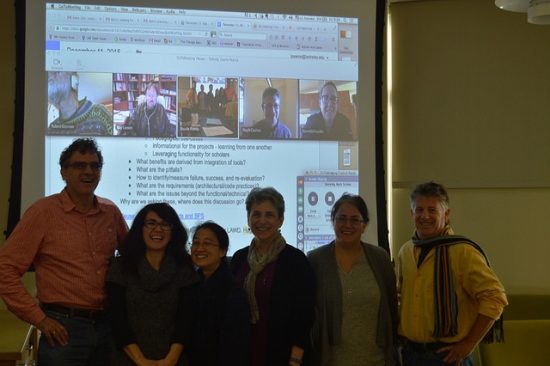Berkeley Prosopography Services, a tool for historical social network analysis originally developed for use with an Uruk text corpus from the Hellenistic period (331-46 BCE), is currently in the process of being generalized for use with a variety of corpora. Project co-directors and DH Fellows Laurie Pearce, Lecturer in Near Eastern Studies, and Niek Veldhuis, Professor in Near Eastern Studies, and technical lead, Patrick Schmitz, Associate Director of Research IT are taking a variety of approaches to developing a robust, reusable tool. With the support of an NEH Digital Humanities Implementation Grant and a Social Science Matrix research seminar grant, the team has gathered scholars and software developers from a variety of relevant projects to discuss issues like disambiguation rules, chronology, and software integration. Participants have been drawn from groups such as the Center for the Tebtunis Papyri, the SNAC Project, the Perseids Project, Trismegistos, the Coptic Scriptorium, and the Old Assyrian Social Network 1950-1750 BCE.
In 2015, Micaela Langellotti, a Postdoctoral Researcher at the Center for the Tebtunis Papyri, worked with Pearce to prepare the first test corpus for the new Berkeley Prosopography Services, with support from a collaborative research grant from Digital Humanities at Berkeley. Langellotti’s corpus contains 16 months of records from the notary office of the Egyptian village of Tebtunis in years 445 and 446 AD. The ledgers include daily records of contracting parties and the nature of their transactions, and the corpus provides a rich snapshot of socioeconomic life in Roman Egypt. During her work at King’s College London, Langellotti compiled the records and built a database for organizing and accessing them.
As Langellotti worked with Pearce, she realized that using the data with BPS would require a reformulation of her database. Databases are not neutral containers of information, Langellotti emphasized. “As I worked with Laurie, I worked to understand the aim of my own database, define its attributes, and determine which attributes were useful for disambiguation. You need to ask, ‘What question does your database intend to answer?’” Though Langellotti had gathered large amounts of data on her topic, her database tables were not well suited for network analysis. When Langellotti initially gathered the data, she was interested in an overview of socioeconomic activities in Tebtunis. As Langellotti’s research interests shifted towards the thousands of people listed in her corpus and their various interconnections, she ran into several problems. Though Langellotti’s original database helped her ask questions about contracts, it made it difficult to trace persons, both as they appeared as contracting parties and other mentions of them as, for instance, neighbors or guarantors. While she was able to facet her database by contract type or date, she could not create a facet for all buyers of houses or all transactions by members of a particular family.
Through a process of consultation with Pearce and attending several Matrix prosopography seminars, Langellotti reformatted her database around a new vocabulary of roles. Instead of focusing on individual contracts, this database represents persons by their roles as buyers, sellers, lessor, lessees, neighbors, etc. Langellotti pointed out that though these roles are straightforward to define, there are tough decision to make as they are applied to the reality of a complex society. Langellotti pointed to slavery as a prime example of this problem. How can slaves be represented in a way that captures both their status as objects and their role as people who are connected with various households? In her original contract-centered database, slaves only appeared in the text of contracts. Because they were objects and not contracting parties, slaves could not be studied as persons who moved between households. In this new person-centered formulation of the database, slaves are represented as persons with attributes such as, “role: slave” and a transaction type (“slave of”) that connects them to another person in the database.
Langellotti advises researchers to take a proactive role in interrogating their database and considering its architecture. Though databases can contain vast amounts of information, the ability to use and access that data can be greatly constricted by a mismatch between architecture and the requirements of a scholar’s research questions and analysis tools.
Interested in building a database for your research? Get in touch with a digital humanities consultant to discuss database design or see other consulting services offered by Digital Humanities at Berkeley.
Image: Langellotti participates in a seminar hosted by Berkeley Prosopography Services and Social Science Matrix
